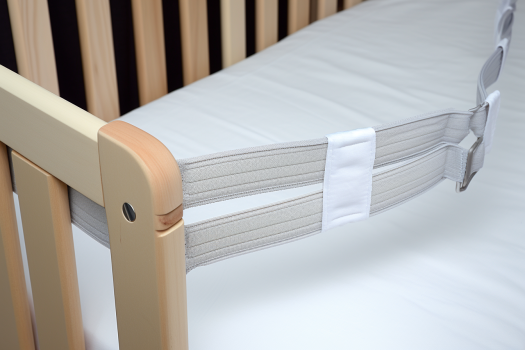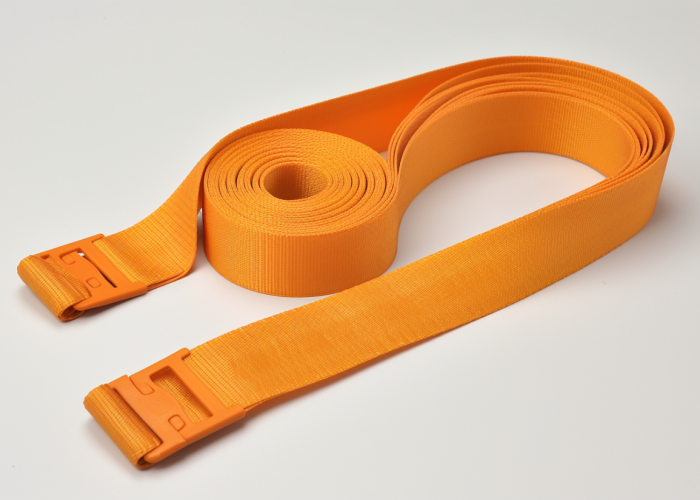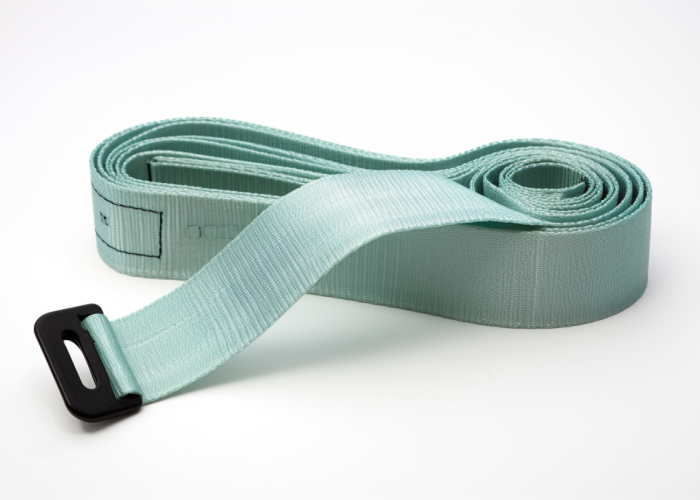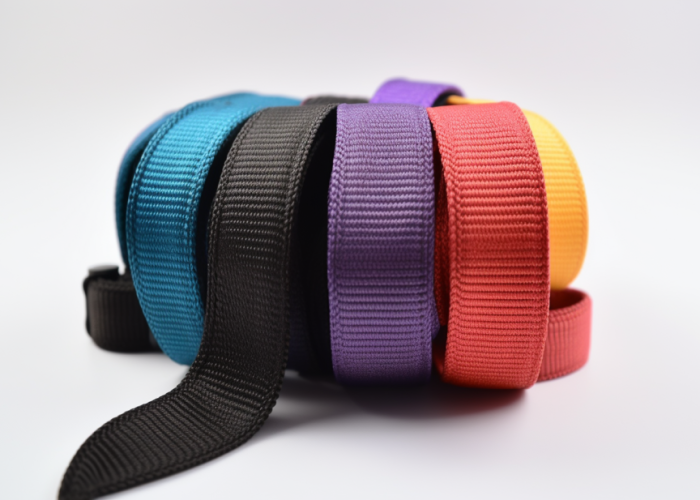Selecting the appropriate material for cot straps directly impacts performance, safety, and durability in load-bearing applications. Material selection affects tensile strength, flexibility, and environmental resistance—all critical factors for engineers and product developers. Our custom webbing manufacturing capabilities allow us to tailor material specifications to your exact application requirements.
The most commonly used materials for cot straps are nylon, polypropylene, and polyester webbing. Nylon offers superior flexibility and strength, polypropylene provides excellent chemical resistance at lower cost, while polyester delivers minimal stretch and high dimensional stability for precise applications.
Explore material advantages, weaving methods, and expert tips to help you select the best webbing for your application’s performance and design needs.


Webbing manufacturing expert with 15+ years of experience helping product developers build high-performance straps for industrial, medical, and outdoor use.
The typical dimensions of cot straps range from 3-5 inches (75-127.5 mm) in width with standard lengths of 1 foot (30.5 cm) or 2 foot (61 cm). These standardized measurements ensure compatibility with common frames while providing sufficient load distribution for safety.
Key Dimensions:
Width specifications vary by intended use. Commercial applications typically use 3-inch webbing for balanced strength and material efficiency. Military applications often require wider 7-8 inch straps to accommodate specialized equipment and extreme loads. Conversely, belt machinery applications utilize narrower 5/8-inch straps for mechanical integration.
The standard length options accommodate different cot sizes and weight requirements. These predetermined dimensions optimize installation flexibility, allowing configuration as either continuous loops or with terminal connectors. Standardization also simplifies replacement and inventory management.
Most cot straps feature a 4,000-pound (18 kN) break strength rating, providing substantial safety margins for normal conditions while accommodating unexpected dynamic loading. This relationship between dimensions and strength follows industry-standard calculations accounting for both material properties and dimensional factors.
Custom dimensions beyond these standards are available when applications require specialized solutions, with engineered specifications maintaining appropriate safety factors for the intended use case.
The most commonly used materials for cot straps are nylon, polypropylene, and polyester webbing, listed in order of popularity. Each material offers distinct performance characteristics that make them suitable for specific applications based on environmental conditions and load requirements.
Key Materials Overview:
Nylon webbing dominates the market due to its exceptional balance of properties, including high tensile strength, flexibility, and abrasion resistance. Its natural elasticity (approximately 20% stretch at maximum load) provides valuable shock absorption for dynamic loading applications while maintaining structural integrity.
Polypropylene offers excellent resistance to moisture, chemicals, and bacterial growth, making it ideal for applications where these factors are concerns. While lacking the stretch properties of nylon, polypropylene provides a cost-effective solution for many applications where rigid support is preferred over elasticity.
Polyester webbing combines excellent strength with minimal stretch, making it the preferred choice for applications requiring dimensional stability and precise load control. Its superior environmental resistance and predictable performance characteristics have made it increasingly popular for critical applications requiring high precision and reliability.
The selection between these materials depends primarily on the specific performance requirements, environmental exposure conditions, and cost considerations of the intended application. Custom blends and specialized treatments can further enhance specific properties to meet unique requirements.

Nylon webbing is ideal for cot straps due to its high tensile strength, natural elasticity (approximately 20% stretch), and excellent resistance to abrasion and UV damage. This combination of properties creates a material perfectly suited for applications requiring both strength and controlled flexibility.
Nylon Webbing Advantages:
The molecular structure of nylon creates unique performance characteristics that benefit cot strap applications. Its polyamide chains form strong hydrogen bonds that provide exceptional tensile strength while still allowing sufficient molecular mobility for controlled elongation under load. This natural elasticity serves as a built-in shock absorption mechanism, reducing peak loads during dynamic events.
Nylon’s exceptional abrasion resistance significantly extends service life in applications involving friction and surface contact. This property makes it particularly valuable for cot straps in high-use environments where repeated loading and unloading cycles occur. The material maintains its structural integrity even after thousands of loading cycles.
The primary limitation of nylon is its hygroscopic nature, which can cause it to absorb moisture in humid environments. While this may slightly alter its dimensional properties, proper manufacturing techniques and treatments can minimize this effect while preserving its valuable performance characteristics.
For applications requiring a balance of strength, flexibility, and durability, nylon webbing remains the industry standard material for cot straps, offering the best overall performance characteristics for most common use cases.
Polypropylene webbing should be used for cot straps in applications requiring excellent chemical resistance, moisture impermeability, and cost-effectiveness. This synthetic material offers unique advantages in environments where exposure to liquids, chemicals, or bacterial growth is a primary concern.
Polypropylene Advantages:
Polypropylene’s molecular structure creates a hydrophobic material that will not absorb water or most chemicals, making it ideal for applications in wet environments or where chemical exposure is common. This property ensures consistent performance characteristics regardless of environmental moisture conditions.
The material’s natural resistance to bacteria and mildew growth makes it particularly valuable in medical and healthcare settings where cleanliness and sanitation are critical factors. Polypropylene straps can be easily cleaned and sanitized without degrading material properties.
While offering less elasticity than nylon, polypropylene’s more rigid performance characteristics can be advantageous in applications requiring dimensional stability. The material provides consistent support with minimal creep under sustained loading, maintaining its original dimensions better than more elastic alternatives.
The primary limitation of polypropylene is its lower UV resistance compared to nylon and polyester, which can affect long-term outdoor applications. However, for indoor use or with appropriate UV stabilizers, polypropylene offers an excellent balance of performance and cost for many cot strap applications.

Polyester webbing offers excellent balance between strength and minimal stretch, making it ideal for cot straps requiring dimensional stability and precise load control. Its superior environmental resistance and predictable performance have made it increasingly popular for critical applications demanding high precision.
Polyester Advantages:
Polyester’s molecular structure creates a material with high tensile strength and minimal elongation under load. This property makes it particularly valuable for applications requiring static positioning and precise load distribution, where the stretching characteristics of nylon would be disadvantageous.
Unlike nylon, polyester maintains its strength characteristics when wet, with minimal dimensional changes in humid or damp environments. This consistent performance regardless of moisture conditions makes it ideal for applications where environmental variables could otherwise affect functionality.
The material’s excellent resistance to UV degradation and environmental factors results in superior longevity in outdoor applications. Polyester webbing maintains its structural integrity and appearance even after extended exposure to sunlight, making it the preferred choice for applications with significant environmental exposure.
For critical applications requiring precise strength characteristics and dimensional stability, polyester webbing provides superior performance and predictability compared to other materials. Its combination of strength, minimal stretch, and environmental durability makes it increasingly popular for high-precision cot strap applications.
The expected break strength of cot straps is typically up to 4,000 pounds (18 kN), with variation based on material, width, and weaving pattern. This high tensile capacity provides a substantial safety margin for normal operating conditions while accommodating unexpected dynamic loading.
Break Strength Comparisons:
Break strength correlates directly with strap width, with wider straps distributing load across more material fibers. A 5-inch strap typically offers proportionally higher break strength than a 3-inch strap of the same material and weave pattern. This relationship allows for precise engineering of strength characteristics based on dimensional specifications.
Material selection significantly impacts break strength properties. While all three common materials can achieve the standard 4,000-pound rating, their performance under various conditions differs substantially. Nylon offers excellent shock absorption through controlled elongation, polyester provides consistent strength with minimal stretch, and polypropylene delivers reliable performance with good chemical resistance.
Weaving pattern directly influences breaking strength. Twill weaves typically provide 25-30% higher breaking strength than plain weaves due to improved yarn packing and better stress distribution. Conversely, satin weaves generally exhibit 15-20% lower breaking stress despite their smooth surface characteristics.
For critical applications, manufacturing processes can further enhance break strength through techniques like heat setting, edge reinforcement, and specialized coating applications. These processes can optimize performance characteristics while maintaining appropriate material properties for the intended use case.

The weaving method significantly affects cot strap performance by determining stress distribution, flexibility, and surface characteristics. Plain weave offers balanced strength, twill provides superior strength with 25-30% improvement over plain weave, while satin creates a smoother surface but with 15-20% less breaking stress.
Weaving Method Impact:
Plain weave represents the most fundamental structure, with warp and weft yarns interlacing at right angles in a 1:1 ratio. This creates a strong, flat, and even surface structure that appears identical on both sides. The balanced nature of plain weave provides consistent performance characteristics with excellent dimensional stability, making it the standard choice for many applications.
Twill weave features a distinctive diagonal pattern created by weft yarns passing over multiple warp yarns. This structure allows for better yarn packing and reduces stress concentration points, resulting in 25-30% higher breaking strength compared to plain weave. The diagonal structure also provides improved flexibility and abrasion resistance, making twill weave ideal for applications requiring superior strength and durability.
Satin weave is characterized by floating yarns that pass over multiple warps before interlacing, creating a smooth surface with distinctive tactile properties. While offering improved comfort and reduced friction, satin weaves typically demonstrate 15-20% less breaking stress than plain weaves. This trade-off between surface characteristics and strength must be carefully considered based on application requirements.
The mechanical properties of each weaving method directly impact durability under various loading conditions. Plain weave offers balanced wear characteristics, twill provides superior resistance to abrasion and repeated loading, while satin creates enhanced surface properties at the expense of some durability factors. Advanced manufacturing capabilities allow for optimization of these characteristics to meet specific performance requirements.
Selecting the optimal material and weave pattern for cot straps requires balancing strength, flexibility, and environmental resistance against application requirements. Nylon, polypropylene, and polyester each offer distinct advantages for specific use cases. Our custom manufacturing capabilities allow us to engineer precision webbing solutions with tailored dimensions, materials, and weave patterns to meet your exact performance specifications.
Pure nylon webbing provides superior shock absorption, excellent tensile strength, and high abrasion resistance. Its natural elasticity (approximately 20% stretch) effectively distributes dynamic loads while maintaining structural integrity, making it ideal for applications requiring both strength and controlled flexibility.
The primary disadvantages of synthetic fibers include UV degradation, temperature sensitivity, and potential chemical incompatibility. Nylon can absorb moisture affecting dimensional stability, polypropylene has limited UV resistance, and polyester, while more stable, typically costs more than alternatives for equivalent specifications.
The expected lifespan of properly manufactured synthetic cot straps ranges from 3-7 years depending on material, use conditions, and load cycles. Polyester typically offers the longest service life with superior environmental resistance, while nylon and polypropylene require more frequent replacement in high-use or outdoor applications.
Nylon webbing is typically 15-20% heavier than equivalent polypropylene straps. While polypropylene offers weight advantages for applications where minimizing mass is critical, nylon’s superior strength-to-weight ratio often justifies the modest additional weight in performance-critical applications.
Common issues when combining materials include inconsistent stretch rates, differing degradation patterns, and complex manufacturing requirements. Hybrid straps may experience stress concentration at material transition points, requiring specialized manufacturing techniques to maintain consistent performance characteristics throughout the strap length.
Beyond plain, twill, and satin weaves, specialized patterns like herringbone, basket, and leno weaves can be used for specific applications. Herringbone offers enhanced grip, basket weave provides increased thickness, and leno creates an open structure with excellent stability and reduced weight for specialized cot strap requirements.